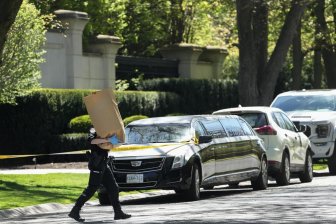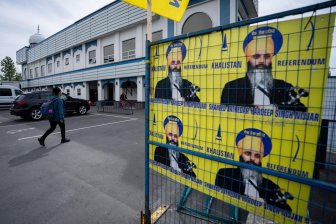NEW YORK – The Occupy Wall Street encampment is gone, but the movement lives on. What nobody knows is just how long it can survive without a place to call home after police hauled away demonstators in a late night raid.

New York’s Zuccotti Park, the privately owned park where protesters against the excesses of capitalism had been camped out since mid-September, was a rallying cry – a symbol of defiance against a government and a society that the protesters wanted to overthrow.
But in recent weeks, the park itself unwittingly morphed into a mirror image of the world it was trying to change: a microcosm of society rife with crime, drug problems and fights over things like real estate and access to medical care.
Some organizers believe the loss of their camp early Tuesday is actually a blessing in disguise.
“This is much bigger than a square plaza in downtown Manhattan,” said Han Shan, an organizer who was working with churches to find places for protesters to sleep Tuesday night. “You can’t evict an idea whose time has come.”
The protesters had vowed to stay put indefinitely. Mayor Michael Bloomberg said he ordered the sweep because health and safety conditions had become “intolerable” in the crowded plaza. The raid was conducted in the middle of the night “to reduce the risk of confrontation” and “to minimize disruption to the surrounding neighbourhood,” he said.
- ‘Summer of discontent’ coming over public service in-office order: unions
- N.S. couple felt they won ‘doctor lottery’ after years on wait-list. Now they’re back on it
- Family says infant killed in 401 crash leaves a ‘void that can never be filled’
- More than half of parents report burnout, U.S. study finds. What can be done?
By early Tuesday evening, some protesters were being allowed back into the park two by two. But they could each take only a small bag after a judge ruled Tuesday afternoon that their free speech rights do not extend to pitching a tent and setting up camp for months at a time.
Pete Dutro, head of the group’s finances, said the loss of the movement’s original encampment will open up a dialogue with other cities and take the protest to the next level of action.
“We all knew this was coming,” Dutro said. “Now it’s time for us to not be tucked away in Zuccotti Park, and have different areas of occupation throughout the city.”
Where will they go next remains unclear. Without a place to congregate, protesters will have a difficult time communicating with each other en masse. The leaders of the movement spent most of Tuesday gathering in small groups throughout the city – in church basements, in public plazas and on street corners – and relaying plans in scattered text messages and email.
For now, they’re planning to move forward with plans for a day of civil disobedience and marches on Thursday, which has been in the works for weeks. And they’ll be joined by angry city leaders who publicly denounced Bloomberg for the nighttime raid.
Robert Harrington, owner of a small importing business in New York, stood outside the barricade with a sign calling for tighter banking regulations.
“To be effective it almost has to move out of the park,” Harrington said. “It’s like the antiwar movement in the ’60s, which started as street theatre and grew into something else.”
“The issues,” he added, “are larger than just this camp.”
The next challenge is figuring out how to decentralize the movement and give it staying power.
“People are really recognizing that we need to build a movement here,” Shan said. “What we’re dedicated to is not just about occupying space. That’s a tactic.”
The aggressive raid seemed to mark a shift in the city’s dealings with the Wall Street protests. Only a week ago, Bloomberg privately told a group of executives and journalists that he thought reports of problems at the park had been exaggerated and didn’t require any immediate intervention.
It was the third raid of a major camp in a span of three days, as police broke up camps Sunday in Portland, Oregon, and Monday in Oakland, California.
The timing did not appear to be coincidental. On Tuesday, authorities acknowledged that police departments across the United States consulted with each other about nonviolent ways to clear encampments. Officers in as many as 40 cities participated in the conference calls.
When New York police began their crackdown at 1 a.m., most of the Occupy Wall Street protesters were sleeping.
Officers arrived by the hundreds and set up powerful klieg lights to illuminate the block. They handed out notices from Brookfield Office Properties, the park’s owner, and the city saying that the plaza had to be cleared because it had become unsanitary and hazardous.
Many people left, carrying their belongings with them. Others tried to make a stand, locking arms or even chaining themselves together with bicycle locks.
Dennis Iturrralde was fast asleep on a cot when the shouting woke him up. Dark figures were running through the tents in the dim orange light of streetlamps. Something slammed into the cot, flipping him to the ground.
“They were tearing everything apart,” Iturralde said. “They were hitting people, spraying people if they didn’t move fast enough.”
Within minutes, police in riot gear had swarmed the park, ripping down tents and tarps. The air was filled with the sound of rustling tarps, rumbling garbage trucks, shouts and equipment crashing to the ground.
Around 200 people were arrested, including a member of the City Council and dozens who tried to resist the eviction by linking arms in a tight circle at the centre of the park.
At least a half-dozen journalists were arrested later in the day, including a reporter and photographer from The Associated Press who were held for four hours before being released.
In contrast to the scene weeks ago in Oakland, where a similar eviction turned chaotic and violent, the police action was comparatively orderly. But some protesters complained of being hit by police batons and shoved to the ground.
—
Associated Press writers Samantha Gross, Verena Dobnik and Karen Matthews contributed to this report.


Comments